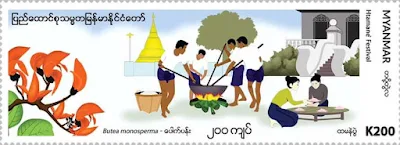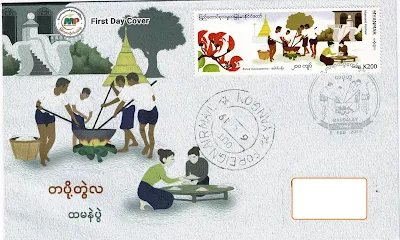 |
| Pazundaung PO |
Myanmar stamps information, philatelic research and post office reports.
Tuesday, 12 February 2019
Pazundaung Post Office
Pazundaung PO is located at No 133, Upper Pazundaung Road, Pazundaung township. It is grade 3 post office and its postal code
is 11171.
Please click the link for the location on the map. Some landmarks near to this post office are Pazundaung train station and Chantha plaza.
I managed to get the new set of postmarks which were introduced in Oct 2018.
Tuesday, 5 February 2019
The month of Tabodwe
The second stamp of the festivals series is for the month of Tabodwe and it was issued on 5 Feb. It is the 1st Waxing of Tabodwe, first day of the month of Tobodwe.
The stamp for the month of Tabodwe featured its seasonal flower Pauk Pan [Butea monosperma] and htamane making festival. Htamane making festival is held in Tobodwe (Jan-Feb). Htamane is a seasonal festive delicacy of Myanmar which is a glutinous rice-based snack mixed with toasted sesame seeds, peanut, fried ginger, fried coconut shavings and ground nut oil. Htamane making competitions are also held around the country.
Quantity : 150,000 pcs each design
Stamp Designers : Wai Zin Paing (MPS)
First Day Covers
The stamp for the month of Tabodwe featured its seasonal flower Pauk Pan [Butea monosperma] and htamane making festival. Htamane making festival is held in Tobodwe (Jan-Feb). Htamane is a seasonal festive delicacy of Myanmar which is a glutinous rice-based snack mixed with toasted sesame seeds, peanut, fried ginger, fried coconut shavings and ground nut oil. Htamane making competitions are also held around the country.
 |
| Stamp design |
Date of Issue : 5 February 2019
Printer : Security Printing Works (Myanmar)
Printing Process : Offset
Stamp Size and Format : 84 mm x 30 mm (Horizontal)
Color : 4
Perforation : 14
Denomination : K200
Sheet Composition : 30 Stamps per SheetQuantity : 150,000 pcs each design
Stamp Designers : Wai Zin Paing (MPS)
Maxicard
Grab your copies at my eBay store.
First Day Covers
 |
| Official FDC by Myanmar Post cancelled at Mandalay |
 |
| FDC produced by Myanmar Philatelic Society (1000 Covers) [MPS-FDC-026] |
 |
| U Mya Thaung |
Monday, 4 February 2019
The 1955 and 1960 globe and hintha type aerogrammes: some discoveries
1. A 1955 watermark error
The
very first globe and hintha type
aerogramme (RW-5) was issued in 1955. It was printed on the “IMPERIAL AIR MAIL”
watermark paper produced by Wiggins Teape. In the production of paper, an
English alphabet was inserted in the watermark to identify the year of
production. Starting from 1948, the letter “A” was inserted in the watermark.
At the beginning of every year, the letter was replaced with the new one while
some letters are skipped. Burma’s 1955 globe and hintha type aerogramme is found printed on the paper with letters
“A”, “B”, “I”, “K”, “L”.
2. A 1960 watermark variety
In late 1960, the simulated perforation was added to the stamp imprint (RW-8). These are found printed on the paper with letters “M”, “O”, “P”, “V” and “Y”. Watermark “P” has two versions. The normal height of the “IMPERIAL AIR MAIL” watermark with all letters is 48 mm, but some copies of watermark “P” are 55 mm in height.
3. Same design but different plate
After printing the sheets on type “P” watermark paper,
the printing plates are recreated. The tablet and indicium are visibly
different from previous types. The white folding line in the tablet is thinner
compared to others. And level of fine details in the indicium is also more
noticeable and some lines are longer in “V” and “Y” types. The differences are
compared in the following figure:
“V” and “Y” watermark papers were produced in 1964 and
1965. The earliest used copy of a “V” watermark aerogramme in my collection is
27 April 1966, commercially used to India. For the “Y” watermark aerogramme, I
have an unsent copy, counter cancelled on 31 August 66. But the earliest
commercial usage I have is 13 May 1967 to Honduras. The succeeding tractor and
oxen aerogramme, “Y” watermarked, was issued on 2 Mar 1967. So we can say that
these two varieties were probably issued in early 1966.
Toe Kyaw Kyar, "The 1955 and 1960 globe and hintha type aerogrammes: some discoveries", The Burma Fantail, Vol. 16, No. 1, Whole Number 59, pp. 14-15, January 2019.
Subscribe to:
Comments (Atom)





